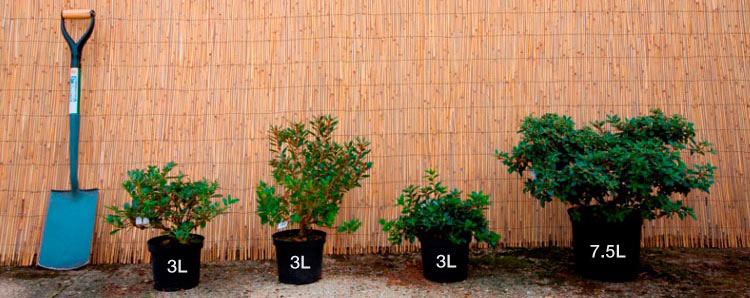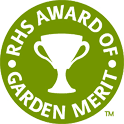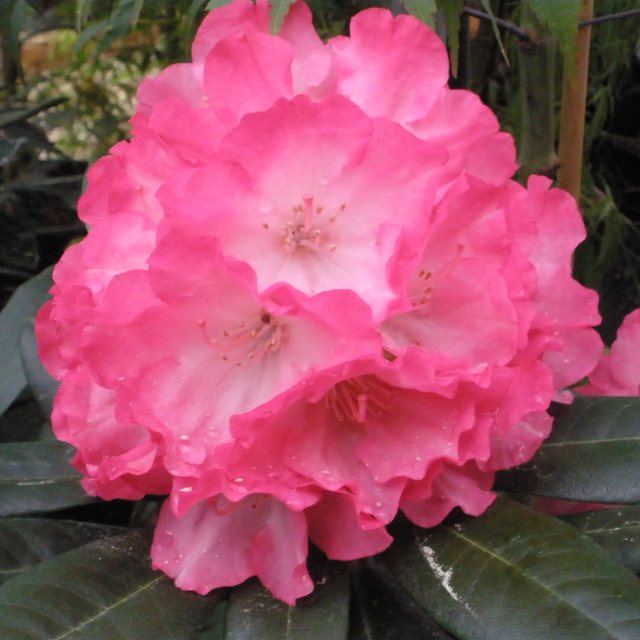Rhododendron Fantastica AGM STANDARD
Item: DFANT
 Currently Unavailable
Currently Unavailable
May
Dark Pink
Not Scented
No
Below -20 °C
Collect in Store
This item is available for collection.
Home Delivery
UK mainland delivery from £8.95
Stunning red flowers with a paler centre fading to an attractive pink in May. We think this is one of Hachmann's best hybrids and one of our favourites and now available as a Standard. It has lovely dark foliage which contrasts well with the flowers.
These Standards have a clean stem of about 80cm and have been top-work grafted at that height, with a lollipop-like head of trimmed branches and flower buds. Standards will always require staking with a good tree-tie to prevent wind damage. They prefer a fairly sunny position. We recommend pruning of the previous year's growth after flowering, to preserve the neat shape of the flower head. Any shoots developing on the stem or from the ground should also be removed to preserve the clear stem.
- Ideal for containers and small gardens.
- Easy to grow.
- Group: yakushimanum.
- Parentage: 'Mars' (s) X yakushimanum 'Koichiro Wada'
- Hybridization date: pre 2000 (1968)
- Bred by Hans Hachmann. Origin: German.
- Habit: Compact bushy.
- Ideal position: Dappled shade.
- Ideal soil: pH 4.5 to 6.0
- RHS Hardiness Rating: H7.
- How we usually propagate this plant: Graft.
- Awards: RHS Award of Garden Merit.
Good to know
Standards
Standard Rhododendrons (grown on a stem) were popular during the first half of the twentieth century, and are now finding renewed interest as they help to provide a variety of flowering heights and interest within the garden. We grow a limited range of rhododendrons and azaleas as standards, grown on a single straight stem. These are ideal for patio pots or formal situations (and better looking than a Bay tree!).
Please note: Standards require a good stake throughout their life to prevent wind damage. Taller standards are suitable for growing in the ground, but only short standards should be grown in pots to avoid being blown over in high winds. Standards such as evergreen azaleas can suffer in cold winters as the stems are more exposed than usual. Consider the use of pipe insulation on the stems in times of hard winters.
If growing in containers, repot into a slightly larger pot every 3 years, using a good ericaceous compost.
The Basics
Ideal soil
Acidic soil, good organic content, pH 4.5-6.0. Inkarho range of rhododendrons will tolerate soils up to pH7.5
Sun or Shade
Light dappled shade is best for most varieties.
Shelter
Refer to hardiness rating. Give young plants protection.
Site Selection
Avoid close to trees, roots, invasive weeds, walls, hot patios, dry banks and waterlogged soils. Do not use weed matting or stone mulch.
Plant spacing
Use the height shown in 10 years as a guide to the distance between each plant. Allow room for plant to fill out. If planting closer for instant impact, be prepared to move plants after a few years.
Compost
- 3 litre pot, dig in 10-20 litres of ericaceous compost.
- 7.5 litre pot, dig in 20-30 litres of ericaceous compost.
- 70-80cm specimen, dig in 60 litres of ericaceous compost.
- 100-120cm specimen, dig in 120 litres of ericaceous compost.
Planting depth
Plant high in the ground, with the top of the rootball visible.
Feeding
Slow-release ericaceous feed recommended in March and straight after flowering.
Mulch
Recommended every few years.
Water
The key ingredient! Keep moist all season, especially the critical time at end of June for flower bud initiation. Tap water is better than no water. Heavy dose at least once per week in dry weather.
Drainage
Ensure good drainage in winter, especially with yellow flowering varieties. Avoid waterlogged sites.
Pruning
Rhododendrons and Camellias: Not normally required. Tidy wayward shoots after flowering.
Evergreen azaleas and Bloombux can be clipped into a low hedge.
Magnolias and Acers: Formative pruning when young to shape into a tree or bush.
Deadheading
Remove old flower-heads, particularly on young or weak plants.
For further advice see here
Size Guide

Delivery & Returns
Our website calculates the delivery charge according to weight and delivery location throughout the UK. To see these charges, please enter your postcode at the checkout, and you will see the charge vary as you add more items to your wheelbarrow.
 Millais Nurseries
Millais Nurseries





